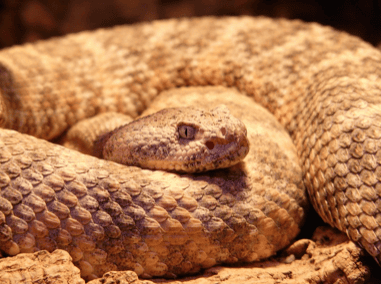 Snakes are one of the most feared animals in the world. For most of us the very word snake sends shivers down our backs. It is only natural to fear them.
Snakes are one of the most feared animals in the world. For most of us the very word snake sends shivers down our backs. It is only natural to fear them.
They are the unknown to most of us. We do not know the species of snake we are close to; therefore, we do not know if it is venomous or not. We just easily assume that they are all venomous and ready to lunge at us any second.
However, did you know that there are over 2,200 species of snakes in the world and less than 20% of them are venomous? So, the big question is how can you tell a nonvenomous snake from a venomous one? Well, it is not as easy as it seems, but we have gathered a few of the more common characteristics that can help you separate the venomous snakes from the non venomous snakes.
Check out the head
Most venomous snakes will have a triangular or diamond shaped head. Non venomous snakes usually have a rounded or curve shaped head. Also, venomous snakes will usually have elliptical cat-like eyes, and non venomous snakes usually have rounded eyes.
However, many of the non venomous snakes have evolved into looking like their venomous partners, so sometimes looks can be deceiving.
Look for a rattle
A rattle is a dead give away for rattlesnakes, which are venomous. However, just as before, some of the species of these snakes have evolved and have become rattle free, but you will still be able to know that it is definitely venomous if the snake rattles at you.
Watch it swim
Did you know that only venomous snakes swim with their entire bodies above the water? So, if you see a snake swimming with its body on top of the water, you can rest assured that it is venomous, and you probably want to leave it alone.
Check out the bite marks
If you happen to be bitten by a snake, you can usually look at the bite marks to tell if it happens to be venomous. If there are two close puncture wounds, indicative of fang marks, then it is most likely venomous, and you should seek medical help immediately.
If the bite mark is ragged and notes the absence of fangs, then you were most typically bitten by a non venomous snake. However, you may still want to get medical help soon. There are many different types of bacteria in a snake’s mouth, and you will most likely need antibiotics to combat the inevitable bacterial infection.
There are always exceptions to the rules of what makes a snake appear to venomous or not. You could research all the common types of poisonous snakes in your area, so that if you do see a snake you will be able to more than likely identify if it is one of the venomous ones.
The best option is to steer clear of any snakes. If you are not sure if it is venomous or not, always assume the worst and slowly leave the area.
If you do not like the snake being so close to your house or yard, you can always call in the professionals who will be able to identify the snake and safely remove it from your property.